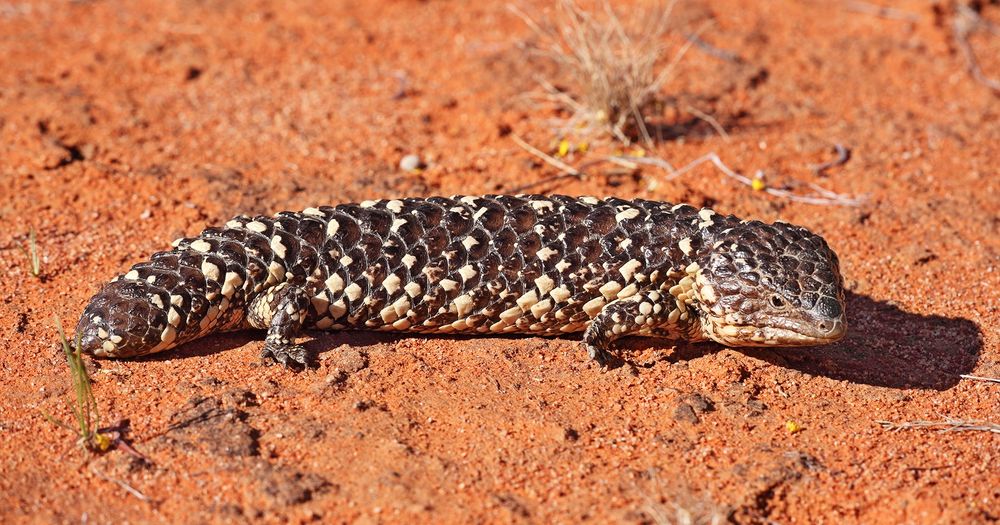#reptiles #ausreptiles #wildoz #inaturalist #nature

#reptiles #ausreptiles #wildoz #inaturalist #nature





Perhaps as a reward, on the way back, I saw TWO stumpies - tiliqua rugosa asper, eastern stickleback, known locally as stumpy-tailed lizards - trundling purposefully across the road! <melt>
Perhaps as a reward, on the way back, I saw TWO stumpies - tiliqua rugosa asper, eastern stickleback, known locally as stumpy-tailed lizards - trundling purposefully across the road! <melt>
Shingleback lizards (Tiliqua rugosa) have a few colloquial names such as sleepy lizards, stumpy lizards or bobtails. Males prove themselves to females by following them around for a couple of weeks before mating. I hope this guy makes the grade 😄

Shingleback lizards (Tiliqua rugosa) have a few colloquial names such as sleepy lizards, stumpy lizards or bobtails. Males prove themselves to females by following them around for a couple of weeks before mating. I hope this guy makes the grade 😄
rescued from dog terrorism.

rescued from dog terrorism.
photo by Kelly Sheldrick.
Like other Bluetongues, a large, stout, not very agile omnivorous skink. This particular species is found in the SW quarter of Australia, & parts of South Australia, Victoria, and NSW.

photo by Kelly Sheldrick.
Like other Bluetongues, a large, stout, not very agile omnivorous skink. This particular species is found in the SW quarter of Australia, & parts of South Australia, Victoria, and NSW.


When available, they love a good flower snack, slurping up daisies with their blue tongues.
(📷: Rhys Moult, rhysatwork on IG)

When available, they love a good flower snack, slurping up daisies with their blue tongues.
(📷: Rhys Moult, rhysatwork on IG)
As the climate continues to change and wildfires increase in frequency...
(📷: Jacqui Barker)

As the climate continues to change and wildfires increase in frequency...
(📷: Jacqui Barker)
The results showed that the lizards rely on chemosensory detection of smoke (but not audio) to begin their escape behavior.
The region these lizards were captured from hasn't had wildfire during their long lifetimes.

The results showed that the lizards rely on chemosensory detection of smoke (but not audio) to begin their escape behavior.
The region these lizards were captured from hasn't had wildfire during their long lifetimes.
Shingleback
Bobtail
'Sleepy Lizard' & my favorite:
Pinecone Lizard.
Let's talk about the time a zookeeper's burnt lunch led to a discovery about how the sleepy lizard survives Australian wildfires.

Shingleback
Bobtail
'Sleepy Lizard' & my favorite:
Pinecone Lizard.
Let's talk about the time a zookeeper's burnt lunch led to a discovery about how the sleepy lizard survives Australian wildfires.
Credit: Matt Clancy Australian researchers have discovered that sleepy lizards (Tiliqua rugosus) can recognize the smell of smoke as a sign of approaching fire and attempt to escape, but they do not respond to the sound of…
Credit: Matt Clancy Australian researchers have discovered that sleepy lizards (Tiliqua rugosus) can recognize the smell of smoke as a sign of approaching fire and attempt to escape, but they do not respond to the sound of…
royalsocietypublishing.org/doi/10.1098/...

royalsocietypublishing.org/doi/10.1098/...
In a groundbreaking study that sheds new light on the complex interactions between wildlife and wildfire, Australian researchers have discovered that sleepy lizards (Tiliqua rugosus) possess an innate ability to recognize the…

In a groundbreaking study that sheds new light on the complex interactions between wildlife and wildfire, Australian researchers have discovered that sleepy lizards (Tiliqua rugosus) possess an innate ability to recognize the…





